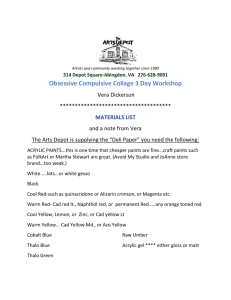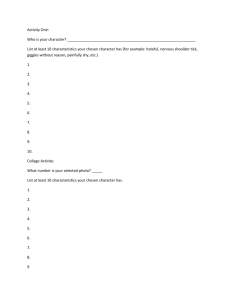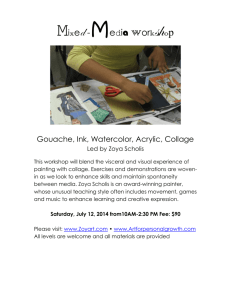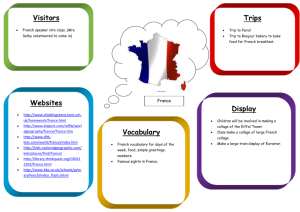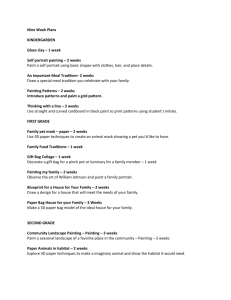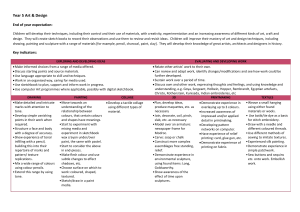CRAFTS
advertisement
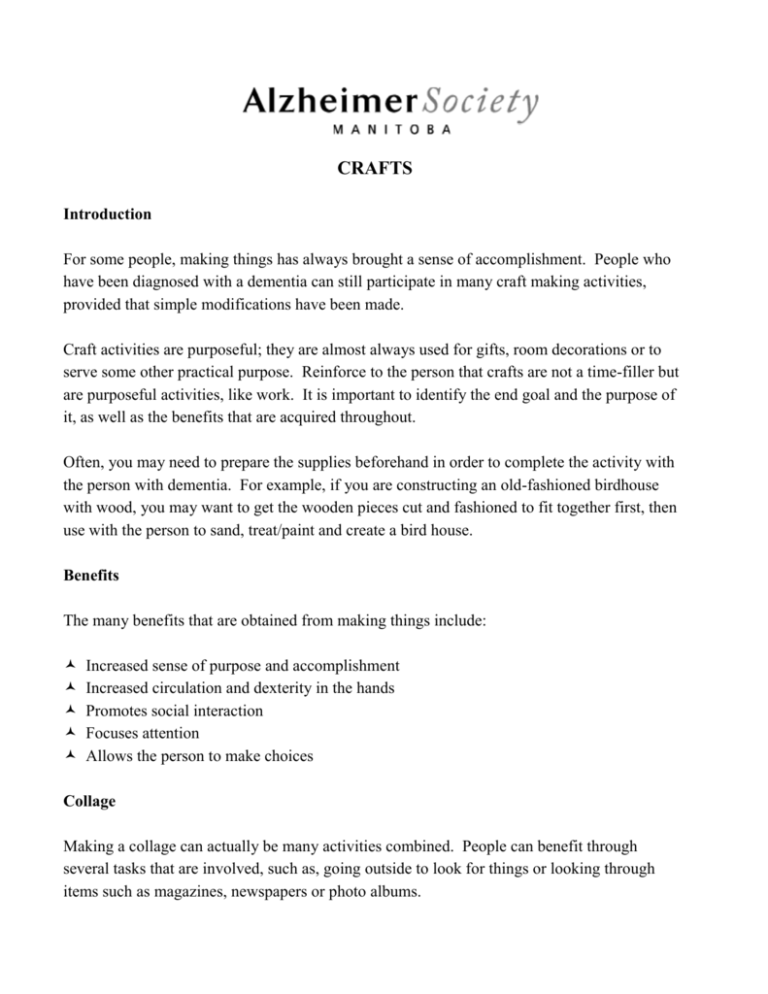
CRAFTS Introduction For some people, making things has always brought a sense of accomplishment. People who have been diagnosed with a dementia can still participate in many craft making activities, provided that simple modifications have been made. Craft activities are purposeful; they are almost always used for gifts, room decorations or to serve some other practical purpose. Reinforce to the person that crafts are not a time-filler but are purposeful activities, like work. It is important to identify the end goal and the purpose of it, as well as the benefits that are acquired throughout. Often, you may need to prepare the supplies beforehand in order to complete the activity with the person with dementia. For example, if you are constructing an old-fashioned birdhouse with wood, you may want to get the wooden pieces cut and fashioned to fit together first, then use with the person to sand, treat/paint and create a bird house. Benefits The many benefits that are obtained from making things include: Increased sense of purpose and accomplishment Increased circulation and dexterity in the hands Promotes social interaction Focuses attention Allows the person to make choices Collage Making a collage can actually be many activities combined. People can benefit through several tasks that are involved, such as, going outside to look for things or looking through items such as magazines, newspapers or photo albums. Here are some activities you can incorporate into making a collage: You could go for a walk and make a nature collage with the different leaves etc that you and the person have found. This can also help bring in a little of the outdoors. You could make a seasonal collage with pictures from magazines, travel brochures, advertisements or pictures that you and the person have taken. This can help with time orientation. You can even incorporate colors into the collage that suit the season; i.e. light blues, yellows and purples for springtime and Easter. You could make a collage of famous people from over the years or of people that are close to the person. It is very important that you are careful not to use the originals of pictures for cutting or pasting, as these may be treasured family keepsakes. Clay Modeling Working with clay can be beneficial in many ways. It is a good activity to exercise fingers and hands, and can be a positive outlet for creative energy or even frustration. Remember to keep this on an adult level. Do not let the person feel as though he/she is participating in a child’s activity. He/she might want to create something, paint and finish it and give it as a gift to someone. Painting Painting is another very valuable expressive activity. Try painting with music playing or try painting outside. It can be a good opportunity for the person to be free to create whatever he/she wants. As always, be mindful of the person’s interests. Someone might not like painting and it can cause that person further frustration if he/she feels forced to participate. Remember that expression and not perfection is the goal. Gifts One way to increase the value of these activities for the person with dementia is if the craft can be made as a gift to someone else. Although you can essentially give anything as a gift that you make, the following are some examples of crafts that a person could make and give as a gift to a family member or friend. Consider: Making a gift box 1. You can purchase papier-mâché boxes from any craft store as well as acrylic craft paints. These boxes can be painted in any way the person wishes to paint them. 2. You can purchase podgy clear acrylic craft sealers or another glaze to finish the box. 3. The person might then want to fill the box with certain items or photos that have special meaning. Please see information on Reminiscing for more about memory boxes. Making a picture frame 1. You could either make this out of pre-cut wooden pieces or by gluing Popsicle sticks/tongue depressors together and decorating them in some way. 2. You could buy papier-mâché frames from craft stores and paint them with acrylic paints. Painting clay pots You can purchase these at any craft store, decorate them with acrylic paints, keep them or give them as a gift. Making stationary 1. You could purchase card-stock or parchment paper and paint or decorate it in some way. 2. You may want to make envelopes to match. Then tie several pages up in a bundle with nice ribbon or raffia and give them as a gift. Wood working If you can get pieces of wood from a lumber store or furniture company, many people will enjoy sorting through them and identifying various grains. Some people may also begin to recall projects that they have done in the past, which could lead to a successful time of reminiscing. If you can get the necessary tools you may want to build something with the pieces of lumber, or consider getting the pieces pre-cut and work on the sanding, treating, or assembling of the wood. Safety 1. All materials used should be non-toxic if the person is experiencing more advanced symptoms of dementia. 2. When working with tools, ensure that you are with the person at all times. 3. If the project includes the use of small objects such as coins, marbles or beads, be cautious. Some people who are experiencing advanced symptoms of dementia may be prone to putting things in their mouths. Things to Remember 1. Break down projects into simple components that are easy to follow. 2. Keep a sample on display at all times in order for the person to visualize the end result. 3. Demonstrate each step as many times as needed for the person to understand it. 4. Reassure, encourage and praise the person at all times. 5. Keep the project on an adult level; do not use objects that are particularly childlike, as this can be demeaning. 6. Don’t forget that there are hundreds of other craft ideas available. Sign out a book from the library or recall a craft that you are familiar with and think about how it can be modified to be suitable for the person with dementia. The possibilities are endless. 7. Keep in mind that this is a means to an end. How the person feels and benefits from the task is more important than what the creation looks like or even how it functions. Remember to allow and foster creativity, even if you don’t find someone else’s creation particularly attractive.

